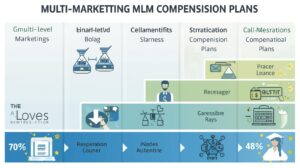The world of direct sales is complex, with various models dictating how individuals earn and grow their businesses. At the heart of one of the most talked-about models—multi-level marketing—lies a foundational concept: MLM levels. Understanding these levels is crucial for anyone considering an MLM opportunity or looking to succeed within one. These structures are the blueprint for how distributors build teams, generate sales, and ultimately create a sustainable income stream.
This guide will break down everything you need to know about MLM levels in 2025. We will explore how these tiered systems are designed, the way they facilitate both personal and team growth, and their direct impact on your potential earnings. You will learn about the different ranks, the qualifications needed to advance, and how the compensation plan is tied directly to your position within the MLM structure. By the end, you will have a clear and comprehensive understanding of how multi-level structures function as the engine for growth and income in the modern MLM landscape.
What Exactly Are MLM Levels?

At its core, an MLM level, often called a rank, tier, or status, represents a distributor’s position within a company’s hierarchical structure. Think of it like a career ladder. When you first join an MLM company, you start at the entry-level. As you meet specific goals—primarily related to personal sales volume and team building—you advance to higher MLM levels. Each new level unlocks greater earning potential, bonuses, and sometimes, prestigious rewards.
The entire system is built on a “downline” concept. Your downline consists of the people you personally recruit into the business and the people they, in turn, recruit. The collective sales activity of this entire network contributes to your ability to climb the MLM levels. This is the “multi-level” aspect of the business model. You earn not only from your own sales but also from the sales made by your team, with the percentage and depth of earnings increasing as you achieve higher ranks.
This structure incentivizes mentorship and teamwork. To advance, you must not only be a good salesperson but also an effective leader who can train and motivate your downline to succeed. The progression through MLM levels is a direct reflection of your ability to duplicate your success throughout your organization.
The Anatomy of a Typical MLM Structure
While every MLM company has a unique compensation plan, most follow a similar foundational structure for their MLM levels. Understanding this general framework helps demystify how these systems work.
- Entry Level (Distributor/Consultant): This is where everyone begins. At this stage, your primary focus is on learning about the products and making personal sales. Your income is typically limited to the retail profit—the difference between the wholesale price you pay for products and the retail price your customers pay.
- Team Builder Levels (Manager/Leader): Once you start recruiting others, you enter the team-building phase. To reach these intermediate MLM levels, you’ll need to meet requirements like a minimum number of active recruits in your downline and a certain amount of total team sales volume. At this stage, you begin earning commissions on the sales of your direct recruits (your first level).
- Leadership Levels (Director/Executive): These higher MLM levels are for those who have built substantial organizations. The qualifications become more demanding, often requiring you to have several leaders within your downline who have also reached manager-level ranks. The rewards are significant, with commissions paid on sales from multiple levels deep within your downline, plus access to exclusive bonuses like car allowances, leadership pools, and incentive trips.
- Top-Tier Levels (Presidential/Diamond): Reserved for the elite performers, these are the highest MLM levels within a company. Reaching this pinnacle means you have cultivated a large, successful, and often international organization with multiple layers of leadership. The income potential here is at its peak, with distributors earning from their entire organization’s sales volume, often with no depth limitations.
The journey through these MLM levels is a process of scaling your efforts from individual sales to team leadership and, finally, to organizational management.
How MLM Levels Drive Growth and MLM Income

The system of MLM levels is not just an organizational chart; it’s a powerful engine for both company and individual growth. It creates a structured path with clear, achievable milestones that motivate distributors to consistently expand their business.
A Clear Roadmap for Business Growth
One of the most significant psychological advantages of the MLM levels system is the clarity it provides. New distributors are not left wondering what to do next. The path is laid out for them: sell products, recruit team members, and help those team members do the same. Each level has specific, measurable requirements.
For example, to advance from “Consultant” to “Manager,” a distributor might need:
- $500 in Personal Retail Sales (PRS) in a month.
- Three personally recruited, active distributors.
- $3,000 in monthly Team Wholesale Volume (TWV).
This checklist gives distributors concrete targets to aim for. It gamifies the process, turning business-building into a series of achievable quests. As they hit these targets and advance to the next level, they receive recognition and increased compensation, reinforcing their efforts and motivating them to aim for the next rank. This structured progression is a key driver of sustained MLM growth.
The Power of Leveraged Income
The core of MLM income potential lies in the concept of leverage, which is unlocked as you climb the MLM levels. At the entry-level, your income is linear—it’s directly tied to the hours you put into making sales. If you don’t sell, you don’t earn.
However, once you start building a team, your income model shifts. By helping your downline succeed, you begin to earn a percentage of their sales. This is leveraged income. You are earning from the efforts of others, not just your own.
Let’s illustrate this:
- At Level 1: You earn 25% profit on your personal sales. If you sell $2,000 worth of products, you make $500.
- At Level 2: You still earn 25% on your sales. But now, you also earn a 5% commission on the sales of your five team members, who each sell $1,000. That’s an extra $250 ($5,000 in team sales x 5%). Your total income is now $750.
- At Level 3: You now have leaders in your team who are also building their own teams. You might earn 5% on your direct recruits, 3% on the recruits of your team (your second level), and so on.
As you advance through the MLM levels, the depth of your commissionable downline increases. Top-level distributors can earn commissions from hundreds or even thousands of people, creating a substantial and scalable MLM income that is no longer dependent solely on their personal efforts.
Incentivizing Leadership and Duplication
A well-designed MLM structure does more than just reward recruitment. It rewards leadership. To reach the higher MLM levels, you cannot simply sign people up and abandon them. Your success is intrinsically linked to their success.
Compensation plans are often structured to require you to develop leaders within your team. For instance, to become a “Director,” you might need to have three “Managers” in separate legs of your downline. This forces you to invest time in coaching, mentoring, and providing resources to your team members. You must teach them how to make sales, how to recruit, and how to lead their own teams.
This process is called duplication. It’s the ability to teach your system to others so they can replicate your success. The entire MLM growth model hinges on this principle. The most successful distributors are not necessarily the best salespeople; they are the best teachers and leaders who can create a culture of duplication throughout their organization. The MLM levels system is the framework that encourages and rewards this critical skill.
Common Types of MLM Compensation Plans and Levels

While the concept of advancing through levels is universal, the mechanics of how you’re paid can vary significantly. Different MLM companies use different compensation plan models. Understanding the basics of these plans is key to evaluating an MLM opportunity.
1. Stairstep Breakaway Plan
This is one of the older and more complex models. Distributors climb a “staircase” of MLM levels by increasing their personal and group sales volume. As they hit certain volume targets, they move up a step and earn a higher commission percentage.
The “breakaway” happens when someone in your downline reaches the same top-level rank as you (or a specific high rank). At this point, their entire group “breaks away” from your personal group volume. You no longer earn the same standard commissions on them. Instead, you earn a smaller “generational” override commission on their entire team’s volume. To keep earning significant income, you must continue building new teams to replace the ones that break away. This plan heavily rewards those who can consistently develop top leaders.
2. Unilevel Plan
The Unilevel plan is simpler and has become very popular. You can personally sponsor as many people as you want, and they are all placed on your first level. Anyone they sponsor is placed on your second level, and so on. The plan creates a structure that can be unlimited in width.
Compensation is paid out based on a set number of levels deep. For example, a company might pay commissions on sales down to five or seven levels. A typical Unilevel payout might look like this:
- Level 1: 7%
- Level 2: 5%
- Level 3: 5%
- Level 4: 3%
- Level 5: 2%
The simplicity of this plan makes it easy to explain and understand. The focus is on building a wide first level and then teaching those people to do the same to drive depth and maximize MLM income.
3. Binary Plan
The Binary plan limits the width of your first level. You can only sponsor two people directly under you, creating two “legs”—a left leg and a right leg. Any additional people you sponsor are placed further down in one of these two legs, a phenomenon known as “spillover.” Spillover can be a powerful motivator, as recruits can benefit from the efforts of those above them in the organization.
In a Binary plan, you are typically paid a commission based on the sales volume of your weaker leg (the “pay leg”). For example, if your left leg generates $10,000 in volume and your right leg generates $8,000, you will be paid a percentage of the $8,000. The remaining $2,000 from the stronger leg is often carried over to the next commission period. This structure heavily incentivizes teamwork, as everyone in a leg benefits from building volume together. Success depends on balancing the growth of both legs.
4. Matrix Plan
A Matrix plan has a limited width and a limited depth. A common matrix might be a 3×5, meaning you can have three people on your first level, and commissions are paid down to five levels deep. Once your first level is full, new recruits automatically spill over to the next available spot in your downline.
The limited nature of the Matrix plan fosters a strong sense of teamwork, as the success of the entire matrix depends on everyone filling their positions. However, it can also cap earning potential since the number of distributors you can earn from is finite. Some modern MLM companies use a “forced matrix,” where the company places new members without a sponsor into the matrices of existing distributors, further enhancing the spillover effect.
The Challenges and Realities of Climbing MLM Levels

While the path to the top of an MLM structure is clearly defined, it is far from easy. The promise of significant MLM income and lifestyle rewards is real for some, but it requires overcoming substantial challenges.
The High Attrition Rate
One of the biggest hurdles in any MLM business is attrition. Many people who join will quit within their first year. They may lose motivation, struggle with sales, or find that the business is not a good fit for them. This means that to grow, you must constantly be recruiting to replace those who leave while also adding new members to expand your team.
Climbing the MLM levels requires building a stable organization, which is difficult when the foundation is constantly shifting. Successful leaders develop systems for onboarding and training to help new distributors achieve early success, which can improve retention rates.
The Sales vs. Recruiting Balance
To progress, you need both personal sales and a growing team. Finding the right balance can be tricky. If you focus only on recruiting, your personal sales volume may suffer, potentially disqualifying you from commissions and bonuses. If you focus only on sales, you will never build the leveraged income that comes from a team.
Higher MLM levels demand excellence in both areas. You must consistently meet your personal sales quotas while simultaneously dedicating significant time to training and supporting your downline. This dual role of salesperson and mentor is a demanding one.
The Reality of MLM Income
It’s important to approach MLM income with realistic expectations. While compensation plans show the potential for high earnings at the top MLM levels, the reality is that the majority of distributors do not reach these ranks. Most participants earn modest supplemental income, and many earn very little or even lose money after accounting for business expenses.
Success is not guaranteed. It is the direct result of skill, persistence, and a significant time investment. The distributors who achieve high MLM levels and substantial incomes are those who treat their MLM venture as a serious business, not a casual hobby. They are disciplined, resilient, and dedicated to mastering the skills of selling, recruiting, and leading.
Tips for Successfully Navigating MLM Levels in 2025

If you are committed to building a successful MLM business, here are some strategies to help you effectively climb the MLM levels and maximize your growth.
- Master Your Company’s Compensation Plan
You cannot win a game if you don’t know the rules. Study your company’s compensation plan until you know it inside and out. Understand the exact requirements for each rank. Know where the bonuses are and what triggers them. This knowledge will allow you to be strategic about your efforts, focusing on the activities that will give you the biggest return and help you advance to the next level most efficiently. - Focus on Income-Producing Activities (IPAs)
In MLM, it’s easy to get bogged down in “busy work” that doesn’t actually grow your business. The most successful distributors are ruthless with their time, focusing almost exclusively on IPAs. These are:
- Finding new customers and prospects.
- Presenting your products or business opportunity.
- Following up with prospects.
- Training and mentoring your new team members.
Prioritize these activities every day. Administrative tasks, endless scrolling on social media, or reorganizing your office are not IPAs.
- Develop a Duplicatable System
Don’t try to reinvent the wheel. Your company likely has a proven system for success. Your job is to master that system and then make it simple enough for anyone on your team to follow. Create simple, step-by-step guides for getting started, making first sales, and recruiting first team members. The more duplicatable your system is, the faster your team will grow, which is the key to advancing through the MLM levels. - Become a Product of the Product
Authenticity sells. You must genuinely love and use the products you are promoting. Your personal stories and testimonials are your most powerful marketing tools. When you are a passionate advocate for your products, your enthusiasm is contagious. This passion will attract both customers and potential business builders who are drawn to your belief in what you offer. - Embrace Personal Development
Building an MLM business is as much a journey of personal growth as it is a business venture. You will face rejection, disappointment, and self-doubt. To succeed, you must constantly work on your mindset, communication skills, and leadership abilities. Read books, listen to podcasts, attend company events, and find mentors who can guide you. The stronger you become as a person, the stronger your business will be. - Lead with Service and Support
Shift your mindset from “recruiting” to “offering an opportunity” and from “managing” to “serving.” Your primary role as a leader is to help the people on your team achieve their goals. Celebrate their wins, offer support when they struggle, and provide them with the tools and training they need to succeed. When your team knows you genuinely care about their success, they will be more loyal, motivated, and productive. This servant leadership approach builds a strong, lasting organization, which is the foundation for reaching the highest MLM levels.
Conclusion: The Blueprint for Your MLM Journey
The system of MLM levels is the fundamental architecture of the multi-level marketing industry. It provides a structured, motivating pathway for distributors to grow a business from the ground up. By rewarding both personal sales and team-building efforts, it creates a powerful model for leveraged MLM income and exponential MLM growth. The journey from a new distributor to a top-level leader is a challenging one, defined by persistence, leadership, and a deep understanding of the compensation structure.
For those considering or currently involved in an MLM, mastering the concept of MLM levels is not just beneficial—it is essential. It is the map that shows you where you are, where you can go, and the exact steps you need to take to get there. By focusing on consistent effort, developing strong leadership skills, and building a supportive and duplicatable team culture, you can successfully navigate the MLM structure and work toward achieving your income and lifestyle goals in 2025 and beyond.


